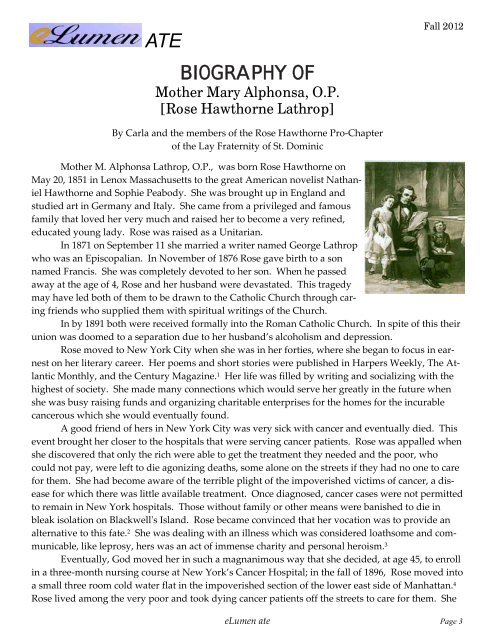eLumenate: Rose Hawthorne - Third Order
eLumenate: Rose Hawthorne - Third Order
eLumenate: Rose Hawthorne - Third Order
Create successful ePaper yourself
Turn your PDF publications into a flip-book with our unique Google optimized e-Paper software.
ATE<br />
BIOGRAPHY OF<br />
Mother Mary Alphonsa, O.P.<br />
[<strong>Rose</strong> <strong>Hawthorne</strong> Lathrop]<br />
By Carla and the members of the <strong>Rose</strong> <strong>Hawthorne</strong> Pro‐Chapter<br />
of the Lay Fraternity of St. Dominic<br />
Fall 2012<br />
Mother M. Alphonsa Lathrop, O.P., was born <strong>Rose</strong> <strong>Hawthorne</strong> on<br />
May 20, 1851 in Lenox Massachusetts to the great American novelist Nathan‐<br />
iel <strong>Hawthorne</strong> and Sophie Peabody. She was brought up in England and<br />
studied art in Germany and Italy. She came from a privileged and famous<br />
family that loved her very much and raised her to become a very refined,<br />
educated young lady. <strong>Rose</strong> was raised as a Unitarian.<br />
In 1871 on September 11 she married a writer named George Lathrop<br />
who was an Episcopalian. In November of 1876 <strong>Rose</strong> gave birth to a son<br />
named Francis. She was completely devoted to her son. When he passed<br />
away at the age of 4, <strong>Rose</strong> and her husband were devastated. This tragedy<br />
may have led both of them to be drawn to the Catholic Church through car‐<br />
ing friends who supplied them with spiritual writings of the Church.<br />
In by 1891 both were received formally into the Roman Catholic Church. In spite of this their<br />
union was doomed to a separation due to her husband’s alcoholism and depression.<br />
<strong>Rose</strong> moved to New York City when she was in her forties, where she began to focus in ear‐<br />
nest on her literary career. Her poems and short stories were published in Harpers Weekly, The At‐<br />
lantic Monthly, and the Century Magazine. 1 Her life was filled by writing and socializing with the<br />
highest of society. She made many connections which would serve her greatly in the future when<br />
she was busy raising funds and organizing charitable enterprises for the homes for the incurable<br />
cancerous which she would eventually found.<br />
A good friend of hers in New York City was very sick with cancer and eventually died. This<br />
event brought her closer to the hospitals that were serving cancer patients. <strong>Rose</strong> was appalled when<br />
she discovered that only the rich were able to get the treatment they needed and the poor, who<br />
could not pay, were left to die agonizing deaths, some alone on the streets if they had no one to care<br />
for them. She had become aware of the terrible plight of the impoverished victims of cancer, a dis‐<br />
ease for which there was little available treatment. Once diagnosed, cancer cases were not permitted<br />
to remain in New York hospitals. Those without family or other means were banished to die in<br />
bleak isolation on Blackwellʹs Island. <strong>Rose</strong> became convinced that her vocation was to provide an<br />
alternative to this fate. 2 She was dealing with an illness which was considered loathsome and com‐<br />
municable, like leprosy, hers was an act of immense charity and personal heroism. 3<br />
Eventually, God moved her in such a magnanimous way that she decided, at age 45, to enroll<br />
in a three‐month nursing course at New York’s Cancer Hospital; in the fall of 1896, <strong>Rose</strong> moved into<br />
a small three room cold water flat in the impoverished section of the lower east side of Manhattan. 4<br />
<strong>Rose</strong> lived among the very poor and took dying cancer patients off the streets to care for them. She<br />
eLumen ate Page 3


